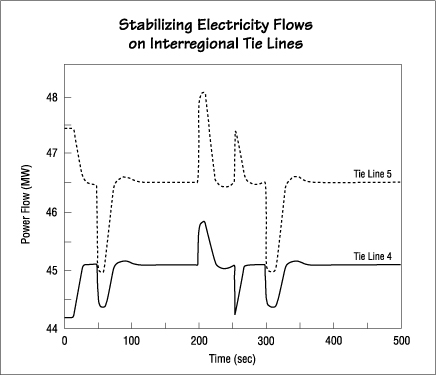As the electric industry becomes increasingly competitive, customers and their representatives are looking for inexpensive power from any source they can find. As a result, more and more electricity is being sent from one regional power system to another. For example, New England, New York, and PJM (serving Pennsylvania, New Jersey, and Maryland) all now import electricity from Canada. With power systems running more efficiently, thus with less excess transmission capacity, those transfers can be critical. On a regular basis, for instance, both New England and California require electricity imported from Canada to meet their systemwide demand.
For system operators, those transfers create new headaches. Conditions on a regional power system can be directly affected by transfers of electricity among other regional power systems. When, for example, New England imports electricity from Canada, flows on the New York system change. As system operators plan, they generally make assumptions about the flows on their "tie lines"--the transmission lines that connect neighboring systems. If those flows become too disruptive, a system operator can complain to the interregional "security coordinator," who oversees interregional flows. The security coordinator identifies the transfer causing the problem and takes steps to curtail that electricity flow by denying access to specific transactions. In the new competitive industry, however, interregional deals disrupt the tie lines so frequently that the security coordinator cannot keep up.
A new concept developed by Dr. Ilic and Mr. Yoon should solve that problem. Their patented design and supporting modeling tools describe the market mechanisms needed to make interregional transmission work better. Central to their approach is having the security coordinator replaced by a more active marketer who can make a profit while allowing the regional transmission providers to make decisions about their own participation in tie-line flow control. This coordinator, called the Interregional Transmission Organization (IRTO), operates physical control devices that ensure that flows on the tie lines remain stable and predictable. When disruption occurs, the control devices take action to correct the fault and return electricity flows on the tie lines to the desired levels. The IRTO then computes the cost of making the correction and charges that cost to whoever caused the problem.
To increase efficiency further, the new design allows market participants to make a profit by running the control devices (typically on generating units) that correct the tie-line flows when necessary. Suppose that New England is importing low-cost electricity from Canada, but that activity disturbs operation on the New York system. Instead of the IRTO's taking action to correct the problem, New York can invest in control devices that can restore its own system to its original condition. The IRTO then charges New England for the trouble it created and pays New York for having corrected it. Aided by New York, New England can take advantage of less-expensive electricity than it can produce itself; and the efficiency of the overall multi-region system increases.
In their patent, Dr. Ilic and Mr. Yoon present a formula for calculating how participants will bid, what deals will be made, and what market prices will be set. Based on those results, they then calculate the interregional transfers that will occur, their impact on the various interconnected power systems, and the control responses that will be taken.
 |
|
A small case study performed by Mr. Collison demonstrates the success of this
system in stabilizing tie-line flows. The curves in the figure above show
flows on two tie lines--numbered 4 and 5--that interconnect two regions during
a typical transaction period. At times, the tie-line flows deviate from their
estimated base value, generally due to variations in regional demand. Any
time such a deviation occurs, the responsible generator adjusts demand so
as to drive the tie-line flows back to the estimated base values. With tie-line
flows close to constant, regional transmission providers can maximize reliability
on their own power systems.
To demonstrate the broader impact of their plan, the researchers performed an analysis of an IRTO for the Northeast region. The assumed IRTO auctions off interregional transactions, taking bids from system operators, transmission providers, marketers, and others. The IRTO then coordinates the activities of the market participants to maintain strict control of tie-line flows for the duration of the transactions. The results of the analysis suggest that the proposed market structure would minimize disruptions due to interregional transactions and maximize the benefits to all participants, namely, inexpensive supply and increased reliability. Implementing the market structure would require new regulations for the IRTO but few changes on existing regional markets and power systems. Indeed, the method appears to work, regardless of the market structures that prevail in the individual regions involved.
This research was supported by the MIT Energy Laboratory's Consortium on New Concepts and Software for Competitive Power Systems: Operations and Management and by the US Department of Energy's Energy Information Administration. Further information can be found in references.
